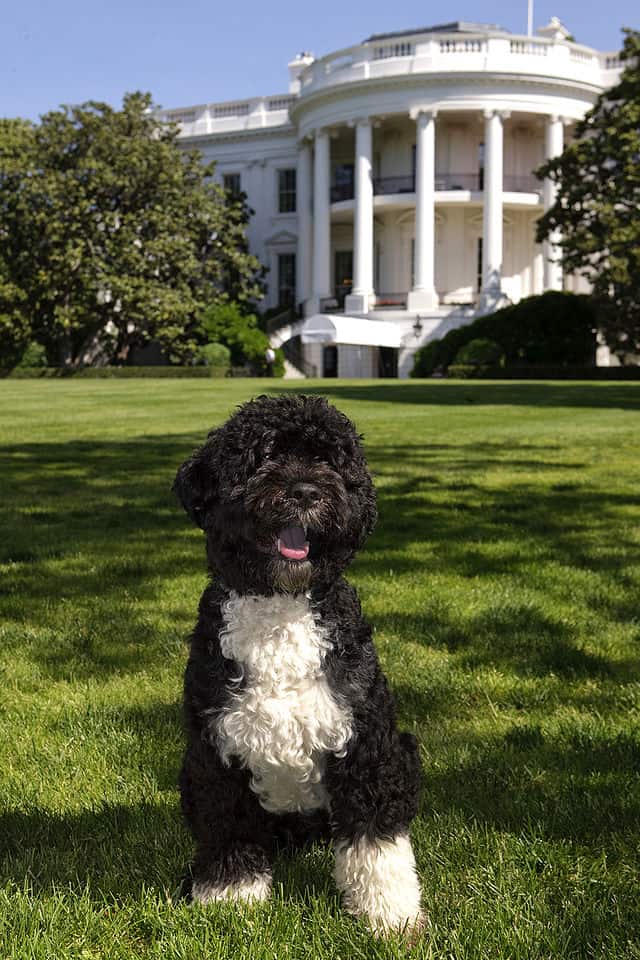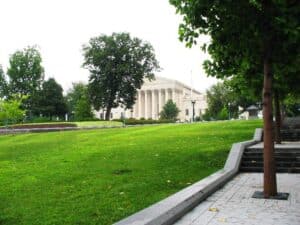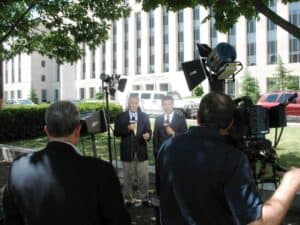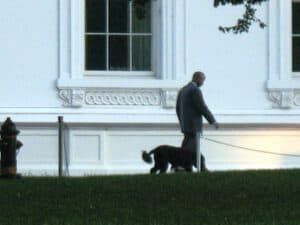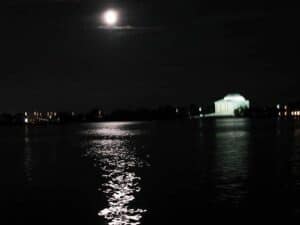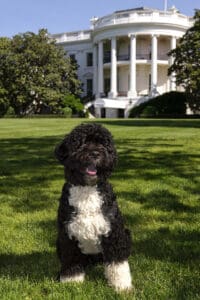
Bo is delighted to be living in the White House, something that probably can’t be said about his master on this particular day.
In the spring of 1782 Colonel Lewis Nicola wrote to General George Washington complaining that for more than six months the soldiers who had defeated the British and won independence for the United States had gone unpaid. He was sick of waiting for the dysfunctional federal government to get its act together and suggested Washington declare himself king to force the issue.
Fortunately for us, Washington reacted with outrage, admonishing Nicola “to banish these thoughts from your mind, and never communicate, as from yourself, or anyone else, a sentiment of the like nature.” Washington admitted that the federal government was a mess but urged patience and forbearance. Eventually things would work out.
Seven years later, inspired by the American Revolution, the French rose up and on July 14th, 1789 stormed the Bastille. The centuries old monarchy fell and for the next 10 years France descended into chaos and bloodshed. Finally, in 1799 the French army under Napoleon Bonaparte suppressed the violence. Weary of the unrest, Bonaparte seized the opportunity Washington had rejected, staging a coup and declaring himself emperor.
July 14th, Bastille Day, was the second day of our two day visit to Washington DC, and once again the United States government was a dysfunctional mess. At the very hour we had been touring the White House, on the next floor up, the President and congressional leaders had been locked in a bitter fight over how to handle the dept ceiling crisis. The government had spent itself into a 14 trillion dollar hole and the two sides were duking it out as the world looked on, horrified.
Sausage Making in the Nation’s Capital
Outside the White House, Chinese tourists were lining up, snapping pictures. My wife and I walked by them on our way to the Supreme Court. We were not on the docket, and the court was not in session, but we were headed there to hear a lecture about the judicial functions of the Court.
During the lecture, nothing was said about the recent stomach churning decisions by the court, decisions that empower corporate lobbyists to buy political elections and permit police to enter homes of private citizens without warrants. Instead, we were invited to admire the court and the many fine things it had accomplished, like striking down the “separate but equal doctrine”, conveniently ignoring the fact that that landmark decision had overturned a previous decision long upheld by the court.
The truth is the Supreme Court isn’t above screwing up. But the myth that those nine white-haired sages are somehow graced with a touch of infallibility hangs in the air. You are invited to breathe it in, to let it stir you, to take it with you and spread it around.
That sort of willful self-delusion may seem less than constructive but Washington DC does a pretty good job of convincing you to give it a try. Take a look around and all you see are handsome neoclassical buildings, vast green lawns, colorful gardens, sparkling fountains, sun-dappled parks and awe-inspiring monuments. To reflect on the sausage-making that goes on behind closed doors spoils the illusion. So when you are invited to indulge in a little myth-making you are inclined to go along.
Occasionally, however, you come across something in Washington so impressive in its own right, something funded and organized by the federal government that actually works, that you are reminded what the country is capable of. Case in point, the Library of Congress.
The Most Beautiful Building in the Country
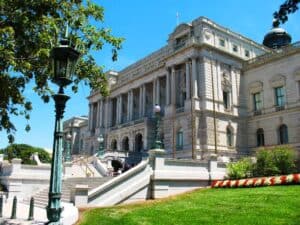
Built in 1897 the Library of Congress shares the same architectural style as the Chicago World’s Fair of the same year.
Originally established as a research library for members of congress, the Library of Congress is today the repository for every copyrighted book, film and recording in the United States. When you publish something in the US you must send two copies to the Library of Congress if requested. Today it is the largest research library in the world with over 32 million books and 838 miles of shelf space.
The foundation of the modern library was the 6,487 books sold to it by Thomas Jefferson in 1815. It was housed originally in the Capitol Building, but when congressmen began tripping over books stacked in the hallways they decided to move it to its own building.
The Thomas Jefferson building completed in 1897 shares the same American Renaissance architectural style as the Chicago’s World Fair of 1893 and the Brooklyn Bridge. More than fifty American painters and sculptors produced works of art for the library which has been called the most beautiful public building in the country.
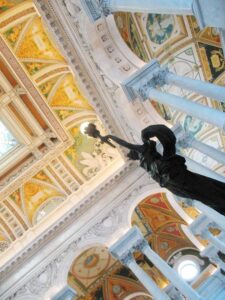
More than fifty American artists produced commissioned works for the library. Click image to see a video tour of the Library of Congress.
The Library is the first entirely electrified building in the United States and the first to be completely wired for the internet.
The one hour tour of the building is well worth it, and, unlike the tours of the White House or the Capitol, is conducted by trained docents who are enthusiastic, knowledgeable and engaging. After the tour you can poke around the many exhibits, attend a gallery talk or look through the collections. You could easily spend an entire day at The Library of Congress and not exhaust all that it has to offer.
Contemplating Journalistic Responsibility
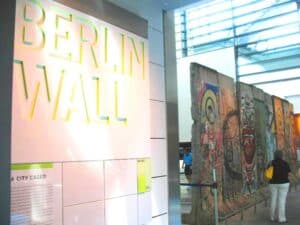
At the Newseum a section of the Berlin Wall is on display. Click image to see a video on the Newseum.
Another Washington institution that deserves the visitor’s time is the Newseum. This institution dedicated to the history of news and journalism in the United States is spread over seven floors and 250,000 square feet. One of Washington’s most recent additions, the Newseum opened at its current location near the National Mall in 2008.
Featuring fifteen theaters, twelve galleries, two broadcast studios and an interactive newsroom, the Newseum is part of the new breed of interactive museums that dazzle as they educated. Here you can debate journalistic ethical dilemmas and compare your answers with reporters, or you can play the role of a news anchor by picking up a microphone and stepping in front of a camera. You can explore the history of television and the internet, or look through a gallery of Pulitizer Prize winning photographs over the years.
The Newseum houses a large section of the Berlin Wall inside of an exhibit covering the collapse of the Soviet Union. A stroll along the front of the building takes you past a fascinating display of up to-the-minute news headlines from around the world. Privately funded, the Nuseum is the perfect antidote to the patriotic myth making of our government funded institutions.
After exploring the Library of Congress and the Nuseum, our itinerary took us past the Federal Courthouse where a pair of ESPN reporters were doing a live feed on the perjury trial of baseball pitcher Roger Clemens, who had been accused of lying to congress about his use of steroids.
The idea that the nation was riveted to this sordid tale of lying, cheating and self-aggrandizement at the very hour when the president was locked in a knock down, drag out fight with congressional leaders over raising the debt ceiling drained away much of the enthusiasm I had been feeling about responsible journalism as depicted by the Newseum.
To make matters worse, my faith in the American legal system was shaken (again) when I learned that the judge had declared a mistrial after prosecutors made a hash of the proceedings by leaving a video screen on in the courtroom while the judge and lawyers privately discussed an issue away from the jury. Clemens, clearly guilty of his crimes, was declared innocent.
What Washington giveth, Washington taketh away. Once more I found myself brooding on the hapless dysfunction of the nation.
Those Who Are Happy to be in Washington DC
I needed a pick me up, and I got it as I walked past the White House. There on the front lawn was perhaps the only member of the White House family ignorant of the predicament the country was in: Bo, the Obama’s dog.
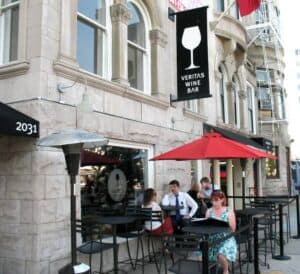
Veritas Wine Bar, a pleasant place to enjoy a glass of wine while you watch the contented residents of Washington DC passing by.
Bo is a Portuguese Water Dog with black curly fur and insanely cute white socks that reach halfway up his legs. He was being walked by a White House staffer and he romped and barked and chased a ball like he was delighted to be living in the President’s house and tickled to be a resident of Washington DC. Something his master was probably not feeling at the moment.
We took the Washington Metro to the Dupont Circle Station and walked up Connecticut Avenue to Veritas Wine Bar. Veritas claims to be Washington’s first and only true wine bar, offering approximately 70 wines by the glass. We sat at a sidewalk table and enjoyed a bottle of syrah as we watched the passersby.
Washington is a unique city in that 38% of its residents work for the government. As a rule, government workers are well paid and not overly burdened at their jobs. Unlike many workers in the private sector, they enjoy good benefits and good job security. Demographically they appear to be a nearly 50/50 mix of whites and African-Americans, and they appear to be largely comfortable with each other, living side-by-side in the rapidly gentrifying suburbs around the district.
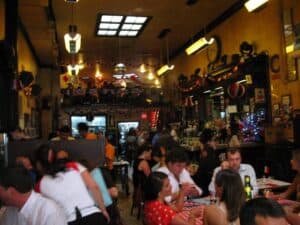
Bistro du Coin on Bastille Day. The French Revolution brought about a feeble republic that lasted all of ten years. Here in the states we did a bit better.
Washington DC used to get a bad rap for being largely a ghetto, but you can roam far and wide these days and see little evidence of the drugs and crime that once infested the city. Rapid job growth in the public sector has brought gentrification on a large scale to the lovely tree-canopied streets of Washington. Forbes named it one of the top cities for job growth in the USA in 2009.
The sense one gets from watching these people is one of contentment. At a time when the rest of the country is racked with anxiety, the people here seem happy and secure. Of course all that is about to change. The budget concessions being hammered out behind closed doors this very day call for dramatic cuts in government spending. A lot of these happy, contented people are about to lose their jobs. But for now, on this sunny July 14th, they are holding onto what they have, unaware perhaps of the pain to come.
Bastille Day in Washington
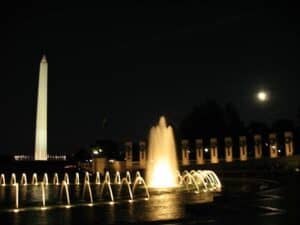
A perfect summer evening at the World War II monument on the National Mall. Click the image for a video tour of the National Mall.
Back in 1789 the French were certainly unaware of the Pandora’s Box they were opening when they chased off the monarchy and embraced the revolution. The bloody mess they initiated eventually brought about a feeble democracy that lasted all of ten years. Nonetheless, to this day they celebrate July 14th as the date of their independence, so we were headed to the Bistro du Coin, one of Washington’s best loved French restaurants, to celebrate with them.
The interior of Bistro du Coin features the warm oak mouldings, mosaic tiles and chalkboard menu of an authentic Parisian brasserie. The food, too, may have been authentic, had it been any other day, but on this one they were trying to jam as many people as possible into the space.
The regular menu was suspended and we were offered a Bastille Day prix fixe, which meant that the chefs were basically making the same dishes over and over again in a manner designed to serve a lot of people all at once. Such an assembly line approach is anathema to good French cooking and we were not terribly impressed with what we got, but the atmosphere was festive and the wine was good and it helped us to relax and reflect.
After two days in Washington, as the country teetered on the brink of financial disaster, we had some things to reflect on.
Embracing the Myth on the National Mall
It was night and a full moon hung above the Washington Monument as we crossed the National Mall before the reflecting pool that stretched away to the steps of the Lincoln Memorial. There in polished white marble sat the one president who, more than any other, had presided over a dysfunctional nation. But he was not alone.
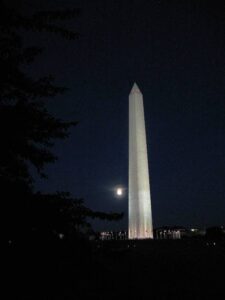
The Washington Monument with a full moon beside it. Washington taught us to keep the faith no matter how dysfunctional the government looks.
As we followed the footpath around the Tidal Basin and saw the moonlight reflecting in the water before the Jefferson Memorial we were reminded that Jefferson, too, had struggled with an uncooperative government and an upstart citizenry. Standing before the FDR Memorial, we read the words of Winston Churchill who said, “You can always count on Americans to do the right thing- after they’ve tried everything else.”
The Korean War Memorial, with its life-sized statues of weary soldiers trudging through the mud, made us think of the misguided military adventures our country has embarked upon, an impression underscored by the thousands of names etched on the black marble of the Vietnam War Memorial.
Believing in the mythology was getting harder and harder. Or was it?
Stumbling Toward Success
Our country has certainly made its share of mistakes. Our history has been riddled with squabbling, backbiting and brinksmanship. Things have often taken too long, and the results have often been less than perfect. But for more than 200 years we’ve managed to hang in there under the same constitution. The French, by comparison, have seen at least 15 different constitutions over the same period.
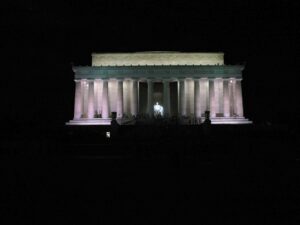
Through most of his presidency Lincoln was reviled by friend and foe alike. Now he is considered our greatest president. Perhaps the American people aren’t always the best judges of good leadership.
Only once did our leaders’ failure to compromise lead to bloodshed. And in spite of the many times we’ve been convinced the country was on the brink of ruin, somehow it’s pulled through. After all, it still belongs to us, even though every curtailment of our freedom in the name of security, every anti-democratic Court decision, every watered down bill adulterated to satisfy the demands of a lobbyist weakens our hold on it. But like George Washington we have to keep the faith.
It’s not easy. For two days I had tried to play along, I had tried to pretend that our government is exceptional, that our leaders are wise and capable, that our vision and purpose are infallible, and I had failed. Call me cynical, but self-delusion was never my strong suit.
Even so, as I was standing before the Lincoln Memorial I found myself getting choked up. I was moved, not by the prospect of some grand American exceptionalism, but by the dysfunctional messiness that drives us all nuts, a fumbling ineptitude that somehow figures it out, like a dimwitted oaf stumbling toward success.
There is something oddly endearing about America, something unique and worth fighting for. America is not upright and unassailable as some like to think, not really, but it is ever striving to become better, and it is endowed with a peculiar faith in its ability to do so.
There is an old English proverb that says, A stumble may prevent a fall.
We have stumbled for sure, but we have always kept going, reaching for an ideal, and have not yet fallen. In the course of things we have achieved something special. As young a country as we are, we are one of the oldest continuously independent nations on earth. And that is, after all, something to be proud of.
Hour by Hour Travel Itinerary for Washington DC (Day Two)…
9:00am-10:30am
United States Supreme Court
East Capitol Street, NE and 1st Street NE
Washington, DC 20002
202-479-3000
9:00am-4:30pm/ Closed on Saturday and Sunday
Arrange a visit to the Supreme Court
10:30am-1:30pm
Library of Congress
Thomas Jefferson Building
10 First SE Street
Washington, DC 20540
(202) 707-8000
Monday-Saturday 8:30am-4:00pm / Closed Sunday
Arrange a visit to the Library of Congress
2:00pm-5:00pm
Newseum
555 Pennsylvania Ave., N.W.
Washington, DC 20001
888-639-7386
9:00am-5:00pm Daily
Plan a visit to the Newseum
5:45pm-7:00pm
Veritas Wine Bar
2031 Florida Avenue NW # 1
Washington D.C., DC 20008
202-265-6270
Mon-Thu,Sun 5pm-2am; Fri-Sat 5pm-3am
Sip and linger at Veritas Wine Bar
7:30pm-9:00pm
Bistro du Coin
1738 Connecticut Avenue Northwest
Washington D.C., 20009
202-234-6969
Mon-Wed 11:30am-11pm; Thu-Fri till 1am; Sat 11am-1am; Sun 11am-11pm
Dine at Bistro du Coin
9:30pm-11:00pm
The National Mall
General visitor parking is available along
Ohio Drive, SW between the Lincoln and
Thomas Jefferson Memorials.
202-426-6841
Visit the National Mall
Previous stop on the odyssey: Washington DC, Part 1 //
Next stop on the odyssey: Charlottesville, VA
Image Credits:
Bo’s Official Portrait, Public Domain; The Supreme Court building, Malcolm Logan; Supreme Court Justices, Public Domain; The Library of Congress exterior, Malcolm Logan; The Library of Congress interior, Malcolm Logan; Newseum, Malcolm Logan; ESPN reporters, Malcolm Logan; Bo goes for a walk, Malcolm Logan; Veritas Wine Bar, Malcolm Logan; Bistro du Coin, Malcolm Logan; World War II Monument, Malcolm Logan; Jefferson Memorial, Malcolm Logan; Washington Monument, Malcolm Logan; Lincoln Memorial, Malcolm Logan

